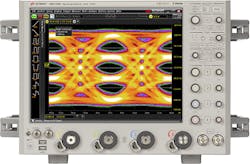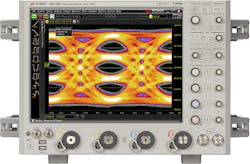Ethernet Continues to Go Faster and Get More Flexible
This file type includes high resolution graphics and schematics when applicable.
It was hard to imagine Ethernet’s staying power when it first appeared on the market almost 35 years ago. It used thick coax. It pumped data at 10 Mbit/s. An entire coax-based Ethernet network could easily be brought down by one bad connection.
These days an RJ-45 with a twisted-pair cable connected to an Ethernet switch or hub is the norm. Only two pairs of the four are used for copper Ethernet connections up to 10 Gbits/s. Cat 5e is needed for 1 Gbit/s Ethernet. At 10 Gbit/s, Ethernet standards eliminate hubs and half duplex operation. Switches are necessary to maintain throughput. Cat 6a or Cat 7 cables are needed for copper connections. These higher-speed connections tend to be found in top-of-rack (ToR) switches.
Higher-speed Ethernet is also available, including 25, 40, and 100 Gbit/s connections. The 25 Gbit/s speed matches the addition of 2.5 Gbit/s Ethernet that increases the signaling speed. The 25 Gbit/s is a 10 Gbit/s system increased in the same fashion. By 2017, 400 Gbit/s Ethernet should show up and will require even more ambitious changes.
Ethernet started with an 8b/10b encoding scheme that has a 25% overhead; 10 Gbit/s Ethernet switched to 64B/66B with a 3.125% overhead. Pulse amplitude modulation (PAM) has also been used to increase throughput. The 1000Base-T specification uses PAM-5, a 5-level scheme. The potential 400 Gbit/s Ethernet standard is looking to use PAM-4 running at 50 Gbaud with four channels to reach the necessary speed (see below).
Fiber use has become more important and more common to accommodate higher-speed Ethernet. It supports much longer runs than copper and it is inherently less susceptible to noise. It tends to be more economical for 10 G Ethernet and above compared to copper.
Higher speeds are critical in the enterprise, but slower versions are very useful in embedded applications. A large number of microprocessors and microcontrollers come with 10/100 Mbit/s Ethernet interfaces. Industrial Ethernet spans a number of standards to provide real-time Ethernet communications running at 1 Gbit/s or slower. There is also the IEEE 1588 Precision Time Protocol (PTP) standard.
The Audio Video Bridging (AVB) standard allows replacement of point-to-point multimedia connections with an Ethernet network. The AVB standard addresses precision synchronization, traffic shaping, and admission controls.
Another standard worth mentioning is Power over Ethernet (PoE). This targets copper Ethernet cabling using 1 Gbit/s Ethernet or lower, providing dc power on the unused RJ45 connections. Most Ethernet cables contain all eight wires, although only four are used for communication at these speeds.
The original IEEE 802.3af-2003 standard promised up to 15.4 W of power. The newer IEEE 802.3at-2009 increased this to 25.5 W. This amount of power is sufficient for a wide range of applications from Voice-over-IP (VoIP) telephones to wireless access points and network video cameras. It reduces device cost since an additional power connection is not required nor is additional cabling needed. Many PoE Ethernet switches can be configured to limit the amount of power as well as providing it on a scheduled basis that may be necessary for some applications.
The trend for wired communication is clearly Ethernet, even if the plethora of standards can be overwhelming.
This file type includes high resolution graphics and schematics when applicable.
About the Author
William G. Wong
Senior Content Director - Electronic Design and Microwaves & RF
I am Editor of Electronic Design focusing on embedded, software, and systems. As Senior Content Director, I also manage Microwaves & RF and I work with a great team of editors to provide engineers, programmers, developers and technical managers with interesting and useful articles and videos on a regular basis. Check out our free newsletters to see the latest content.
You can send press releases for new products for possible coverage on the website. I am also interested in receiving contributed articles for publishing on our website. Use our template and send to me along with a signed release form.
Check out my blog, AltEmbedded on Electronic Design, as well as his latest articles on this site that are listed below.
You can visit my social media via these links:
- AltEmbedded on Electronic Design
- Bill Wong on Facebook
- @AltEmbedded on Twitter
- Bill Wong on LinkedIn
I earned a Bachelor of Electrical Engineering at the Georgia Institute of Technology and a Masters in Computer Science from Rutgers University. I still do a bit of programming using everything from C and C++ to Rust and Ada/SPARK. I do a bit of PHP programming for Drupal websites. I have posted a few Drupal modules.
I still get a hand on software and electronic hardware. Some of this can be found on our Kit Close-Up video series. You can also see me on many of our TechXchange Talk videos. I am interested in a range of projects from robotics to artificial intelligence.



